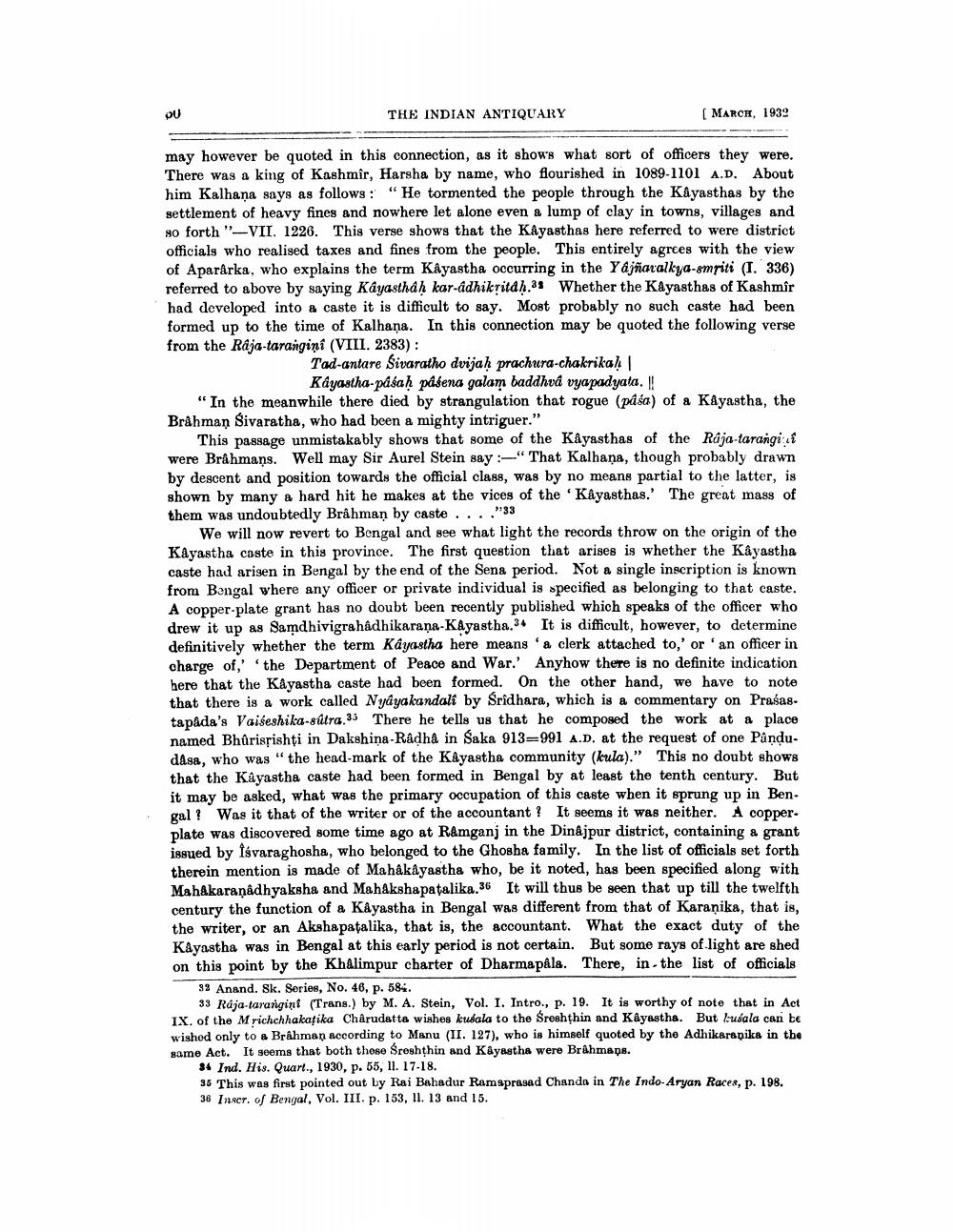________________
OU
THE INDIAN ANTIQUARY
[ MARCH, 1932
may however be quoted in this connection, as it shows what sort of officers they were. There was a king of Kashmir, Harsha by name, who flourished in 1089-1101 A.D. About him Kalhana says as follows: "He tormented the people through the Kayasthas by the settlement of heavy fines and nowhere let alone even a lump of clay in towns, villages and so forth "-VII. 1226. This verse shows that the Kåyasthas here referred to were district officials who realised taxes and fines from the people. This entirely agrees with the view of Aparårka, who explains the term Kâyastha occurring in the Yajñaralkya-smriti (I. 336) referred to above by saying Kayasthah kar-adhikritah.38 Whether the Kayasthas of Kashmir had developed into a caste it is difficult to say. Most probably no such caste had been formed up to the time of Kalhana. In this connection may be quoted the following verse from the Raja-tarangini (VIII. 2383):
Tad-antare Sivaratho dvijah prachura-chakrikal
Kdyastha-pásah pasena galam baddhvá vya padyata.! "In the meanwhile there died by strangulation that rogue (pasa) of a K&yastha, the Bråhman Sivaratha, who had been a mighty intriguer."
This passage unmistakably shows that some of the Kayasthas of the Raja-tarangi df were Brahmans. Well may Sir Aurel Stein say :-" That Kalhana, though probably drawn by descent and position towards the official class, was by no means partial to the latter, is shown by many a hard hit he makes at the vices of the Kayasthas.' The great mass of them was undoubtedly Brahman by caste ...."33
We will now revert to Bengal and see what light the records throw on the origin of the Kayastha caste in this province. The first question that arises is whether the Kayastha caste had arisen in Bengal by the end of the Sena period. Not a single inscription is known from Bangal where any officer or private individual is specified as belonging to that caste. A copper-plate grant has no doubt been recently published which speaks of the officer who drew it up as Samdhivigrahadhikarana-Kayastha 3* It is difficult, however, to determine definitively whether the term Kayastha here means 'a clerk attached to,' or 'an officer in charge of the Department of Peace and War. Anyhow there is no definite indication here that the Kayastha caste had been formed. On the other hand, we have to note that there is a work called Nyayakandali by Sridhara, which is a commentary on Praśas. tapada's Vaiseshika-sútra 35 There he tells us that he composed the work at a place named Bhûrissishţi in Dakshina-Râdha in Saka 913=991 A.D. at the request of one Pandudåsa, who was "the head-mark of the Kayastha community (kula)." This no doubt shows that the Kayastha caste had been formed in Bengal by at least the tenth century. But it may be asked, what was the primary occupation of this caste when it sprung up in Bengal? Was it that of the writer or of the accountant ? It seems it was neither. A copper. plate was discovered some time ago at Ramganj in the Dinajpur district, containing a grant issued by fśvaraghosha, who belonged to the Ghosha family. In the list of officials set forth therein mention is made of Mahâkâyastha who, be it noted, has been specified along with MahAkaranâdhyaksha and Mahakshapatalika.36 It will thus be seen that up till the twelfth century the function of a Kayastha in Bengal was different from that of Karanika, that is, the writer, or an Akshapatalika, that is, the accountant. What the exact duty of the Kayastha was in Bengal at this early period is not certain. But some rays of light are shed on this point by the Khalimpur charter of Dharmapala. There, in the list of officials
32 Anand. Sk. Series, No. 46, p. 584.
33 Raja-tarangin (Trans.) by M. A. Stein, Vol. I. Intro., p. 19. It is worthy of note that in Act IX. of the Mrichchhakatika Chårudatta wishes kusala to the Sreshthin and Kayastha. But lousala can be wishod only to a Brahman according to Manu (II. 127), who is himself quoted by the Adhikarapiks in the game Act. It seems that both those Sreshthin and Kayastha were Brahmaps.
34 Ind. His. Quart., 1930, p. 55, 11. 17-18. 35 This was first pointed out by Rai Bahadur Ramaprasad Chanda in The Indo-Aryan Races, p. 198. 38 Inscr. of Bengal, Vol. III. p. 153, 11. 13 and 15.




